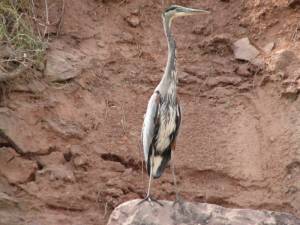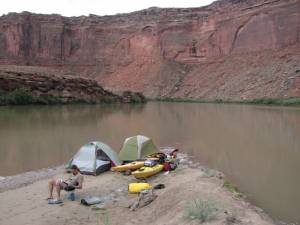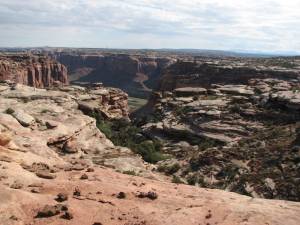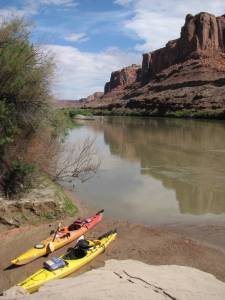Missing the ridge
We awake with our brains clouded from the effects of last night’s wine and whiskey. We say little as we break camp, reload our boats and shove off into the river. I fight to clean my river sandals of the omnipresent river muck. It will take me several days to devise a plan that actually works.
The rafters are still eating breakfast as we paddle past, but we soon find ourselves among the Colorado kayakers. We feel like a water-bound Harley gang as we paddle downstream through increasingly towering canyon walls. They’re a friendly bunch, some of whom are new to Labyrinth Canyon while others in the group have paddled it many times before. We exchange information about points of interest as they approach and become better acquainted with one another.

We spot the River Register, where for more than a century river travelers have carved their names and the dates into the canyon wall. Great Blue Herons silently guard the river banks. Less than 10 miles into our day we reach Bowknot Bend, named by Powell for the circuitous route by which the river loops back on itself over the course of the next five miles to return to a point only a few hundred yards away from where it started. From photos I’ve seen, the view of the phenomenon from the Bowknot Bend Ridge separating the two stretches of river is nothing short of stunning. From an earlier canoe trip Jon recalls that the trail to ascend ridge begins at the far end of the bend. The kayakers disappear as we decide to float through the far side of the bend to lunch aboard our boats. We’re disappointed, however, to find no trail once we return to the ridge. We hear a yell from above and see the Colorado kayakers waving down to us from their perch atop the ridge, enjoying the unique view that will elude us on this trip. Apparently we didn’t exchange enough information, or at least the right information.

Disappointed by our error, we continue downstream for several miles to camp at the tail end of a sandbar island adjacent to the mouth of Two Mile Canyon. While ravenous mosquitoes are thick in the Tamarisk growing on the island’s northern half, the southern tip is hard, flat sand free of the annoying insects. We pitch our tents at the island’s extreme tip and cook our second night’s hearty dinner, penne tossed with a dry Italian sausage and topped with a rich Aribbiatta sauce and grated Pecorino Romano cheese. A light rain shower passes by to our east and leaves a brilliant rainbow across the river in its wake. Having learned our difficult lesson, we take it easy on the wine tonight.
Above the rim
It’s still unseasonably warm for this time of year. Wishing to eschew the hot afternoon sun we decide to begin our day with a hike and paddle through the cool river water during the afternoon. Immediately across the way sits Two Mile Canyon, and according to Jon’s out-of-print guidebook there’s a five-window arch in the sandstone layer at its top.
We leave our camp behind on the island and paddle our empty kayaks across the river to the mouth of the canyon’s dry wash. Here the Tamarisk trees extend only a hundred feet before the water’s edge and they’re easy to negotiate. Thereafter we hike up the open wash to a fork in the canyon. The guidebook says to go right.

The book’s author, Michael Kelsey, is long on history but short on directions in his canyon descriptions. We reach another fork in the canyon and it’s unclear which one we’re to ascend. We choose left, and scramble up a steep rock fall that gains access to the otherwise inaccessible canyon rim. We’re thankful to have the shade of the canyon wall to shield us from today’s intense sun, but by the time we reach the rim we realize that we ascended via the wrong fork. We’re nonetheless rewarded for our efforts by endless vistas across the sandstone plain through which the river carved its course. Through a cleft in the canyon we’re able to spot our camp on the island in the river far below. Now in our third day on the river it’s somewhat refreshing to be able to see out of the canyon we’ve been trapped in thus far.
Having ascertained our ascent route, the descent back to the canyon floor goes much more quickly. We paddle back to our island, break camp and again eat lunch while floating with the river’s current. Further downstream we catch a glimpse of the 1909 inscription by the crew of the Launch Marguerite¸a steam-powered river vessel that once ferried equipment and supplies to miners working near the Confluence.

Our next stop is at Hellroaring Canyon, a broad dry wash that contains the 1836 inscription of Denis Julien, a French fur trapper from New Orleans who is thought to be one of the first Caucasians to wander this area and one who prolifically left his mark upon the land. At least we’re told that it’s there, for try as we might we can’t find it. We return to the water wishing that the guide books we’re using included GPS coordinates.
Several miles downstream of Hellroaring Canyon is Mineral Bottom, the single point upon our 101-mile journey where a navigable road meets the river. It also forms the demarcation between Labyrinth Canyon above and Stillwater Canyon below. The Colorado kayakers will leave us here at the end of their voyage, and we exchange pleasantries as we paddle past.
We set up our third night’s camp a few miles downstream on a bar created by the silt deposited by the wash at Horsethief Bottom. Jon wonders at the place names chosen by the area’s earlier cowboys, noting that there’s no place back East named “Grand Larceny Bottom.” We have here a broad beach, and the silt from the wash minimizes the river muck at the water’s edge. I take the opportunity to wade into the river with a bottle of soap. I also get to “enjoy” my first experience with what I’ve coined the “poop tube,” an altogether unpleasant process mandated by the river’s permit requirements. Tonight’s menu features chicken quesadillas grilled with fresh shredded mozzarella, diced onions and jalapeños, and hot sauce. It’s a hearty dinner, and we sleep well before nine o’clock.
(Go to next page below)

